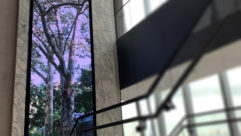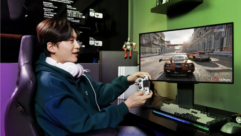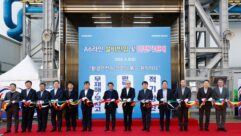Banking On A Videowall Display
The business world has been using the phrase ?time is money? for so long it has become little more than a clich? marketing buzz phrase, but Denmark-based Jyske Bank takes the maxim very seriously. In an effort to give its customers real-time access to their funds, Jyske was one of the country’s first banks to offer online banking with worldwide access, helping to establish its reputation as an early adopter of advanced technology applications.
Information on demand
CHALLENGE: To give a staff of bank employees real-time access to constantly changing financial market data without disrupting 24-hour trading or compromising security.
SOLUTION: Design a videowall that maximizes available space and displays live video from several analog sources.
THE BUSINESS world has been using the phrase “time is money” for so long it has become little more than a cliché marketing buzz phrase, but Denmark-based Jyske Bank takes the maxim very seriously. In an effort to give its customers real-time access to their funds, Jyske was one of the country’s first banks to offer online banking with worldwide access, helping to establish its reputation as an early adopter of advanced technology applications. So when the time came in 2002 to put that theory to work for its employees, senior management undertook a trading floor upgrade that included the installation of a nearly 300-square-foot videowall that would keep traders apprised of world events affecting the constantly shifting financial markets.
The dollar — or in Denmark’s case, the krone — never sleeps. The 24-hour nature of currency exchange demands quick action at all times of day to turn the best profits for investors, and that means traders must be aware of events that could affect the market as soon as they happen. Before Jyske undertook the trading floor upgrade, traders had access to several financial news outlets, but they were spread out and not always easy to view at once. Each trader’s desktop was equipped with two or three TVs tuned to CNN or CNBC, and several small monitors located around the trading floor broadcast additional news sources. To make matters worse, transmissions could be delayed by as much as 15 minutes — a lifetime in the financial world.
According to Michael Stjernholm, Jyske’s IT trading floor coordinator, the situation handicapped the bank’s employees. “Not all of the traders had full access to the exchanges,” he says. “And by not receiving those exchanges as they took place, they couldn’t accurately respond to the prices through the execution of trades or by informing their customers.”
The task of narrowing that information divide fell to Copenhagen, Denmark-based AV systems integrator Informationsteknik Scandinavia A/S. Jyske had worked with the systems integrator before, which eliminated the fits and starts of the typical getting-to-know-you period, but the project’s goal was no less daunting because of it: to design and install a display wall visible to everyone on the trading floor that would combine the disparate news feeds that had been spread out around the room, and do it without disrupting the staff that worked 24 hours a day.
The 35 50-inch Clarity Puma XP rear-projection AP/LCD cubes that make up the current videowall weren’t the first screens Informationsteknik installed to try to shore up Jyske’s financial news disconnect. Until a permanent solution could be agreed upon, the systems integrator installed six 50-inch plasma displays on the wall at the end of the trading floor. It was only a temporary fix, and the bank hoped to find a system that could display a variety of signals, including the slide presentations used during morning briefings.
On the advice of Kim Rasmussen, a sales consultant for Informationsteknik, the bank settled upon a 5×7 arrangement of the Puma cubes. The heart of the videowall is the Jupiter Fusion 980 controller. The integrator first installed the 970 model, but soon switched to the 980 when it became clear the bank would need a more powerful controller to handle the constantly shifting video configurations.
Although the videowall is capable of displaying 35 videos at once, it’s currently configured for eight VGA sources and four analog video sources. Located in a room more than 100 feet away and connected by nearly a mile of Draka RGBHV cables, the controller breaks up the videowall into at least two TV news broadcasts, market index curves, a PowerPoint presentation, and a 2 1/2-foot tall ticker that scrolls across the seven screens at the bottom of the 23-foot wide videowall.
Digital video has become the norm for many AV installations, but Jyske opted for analog. Despite having digital capability with the Puma cubes, three years ago when the bank undertook the project, digital feeds were too expensive and couldn’t be justified. A separate network for carrying the multiple sources was not in the budget, and security concerns also played a part in the decision. The amount of money that changes hands on any given day at a bank the size of Jyske create the need for an infinitely more secure network than might be in place at the typical commercial facility, and Rasmussen says he didn’t have clearance to connect the Fusion controller to the bank’s existing data network, further ruling out the possibility of digital.
Banking On A Videowall Display
The business world has been using the phrase ?time is money? for so long it has become little more than a clich? marketing buzz phrase, but Denmark-based Jyske Bank takes the maxim very seriously. In an effort to give its customers real-time access to their funds, Jyske was one of the country’s first banks to offer online banking with worldwide access, helping to establish its reputation as an early adopter of advanced technology applications.
Presentation is paramountA COMBINED APPROACH TO CONTROLLED CHAOS
The capabilities provided by the cubes came at a price, however. At 130 pounds apiece, they combined to create a 2 1/2-ton installation nightmare that nearly required a degree in structural engineering to overcome. In fact, Rasmussen’s team subcontracted the work to a building engineer, who designed a metal support structure capable of holding the wall without overpowering the aesthetics of the display. Pre-installation load-bearing tests verified the structure could hold eight times the weight of the video display. And with such a heavy load to support, nothing less than exact was acceptable. Laser guides were used to make the measurements with an accuracy of ±1 mm.
Despite the massive size of the videowall, visibility presented concerns from the outset. The several skylights that dot the ceiling of the trading area were capable of flooding the room with ambient light on sunny days, creating the potential for glare and a reduction in image clarity. Rasmussen chose the Puma cubes, in part, because he was confident their two 180 W lamps could provide the brightness necessary to overcome the light pollution.
The bustling nature of the trading floor necessitated special attention to the audio system as well. What good is video of financial analysts if you have to read their lips? Informationsteknik installed nine D&B Audiotechnik speakers around the room, which were tied back to a Sony SRP-X351P mixer/amplifier back in the control room.
As a second level of insurance, though, Rasmussen designed the wall around an AMX NetLinx control system that could respond to increased light levels and turn on the second lamp when necessary. In the original plan for the videowall, only one lamp would be running in each cube under normal conditions. A photo optic sensor on the control system was to be set to a predefined level at which the second lamp would activate. However, he says after the installation was complete he realized even normal light levels would require both lamps to operate at all times.
The physical installation presented the biggest challenge of all. Because of the high priority the bank places on tracking and responding to market information from around the world in real-time, the trading floor is never closed. From the opening bell in Australia on Monday morning, to the close of trading on Wall Street on Friday afternoon, Jyske’s traders are at their desks and on the phone, working in eight-hour shifts. So the bank couldn’t afford a minute of downtime. Informationsteknik’s team worked several days late into the night in an effort to finish as quickly as possible. The project was completed in just less than five days. “Jyske wanted the wall up and working quickly,” Rasmussen says. “And it wasn’t easy because we were in a working environment where we had to be careful about how much noise we made during the installation.”
The cubes that the bank chose provide XGA (1024×768) resolution. Combined, the 35 units that make up the wall display have a resolution of more than 27 million pixels, which is beyond what would be necessary for traders on the floor to read and interpret the news from nearly any point in the room. For Stjernholm and Jyske, though, the trading floor upgrade was about more than just giving employees what they needed. It was about presentation.
Although the price of the installation is confidential, the net value of the project was about more than just money. Jyske is one of the largest banks in Denmark, and its executives are often called upon for interviews and to offer market analysis to local and international media. Anders Dam, the head of Jyske Bank and the subject of many of those interviews, wanted the videowall to act as a symbol of the bank’s commitment to technology and the backdrop for any on-site interviews.
FOR MORE INFORMATION
AMXwww.amx.com
Claritywww.clarityvisual.com
D&B Audiotechnikwww.dbaudio.com
Drakawww.drakausa.com
Jupiterwww.jupiter.com
Sonywww.sony.com
It’s been nearly three years since the installation of the massive videowall at Jyske Bank, and Stjernholm is still pleased with the results. He set out to commission a project that would increase the bank’s credibility as a technology-friendly center and fortify its status as a provider of financial trend analysis, and to that end he succeeded. In the past three years, Jyske executives have conducted nearly 70 interviews with national TV news outlets from the trading floor. (It doesn’t hurt that the bank also had its own mini studio installed on-site to make its employees more available to the media.)
But more importantly, the staff of traders is better equipped to respond to the ever-changing markets in time to make smart decisions for its investors. “The display system has made a tremendous impact on trading floor response time,” Stjernholm says. “It allows traders to have access to breaking news in real time, share and collaborate on decisions, and get immediate assistance from the IT department when help is required.
With its multiple video feeds and constantly changing configuration, the 5.5 million-pixel videowall was already a challenge for Informationsteknik from a control standpoint. But when Jyske Bank decided it also wanted video of a stock ticker to continually scroll across the bottom of the display, Rasmussen decided an upgrade to the Jupiter Fusion 980 display wall processor would be necessary. Capable of handling as many as 32 video sources, it gave the bank’s IT department the power necessary to size, move, and manipulate the various TV feeds throughout the day.
The controller’s ControlPoint software, which allows real-time video windows to be freely moved, scaled, and placed on the display at will, was a match for the AMX NetLinx system’s touchpanel. The IT manager has a series of predefined window layouts to choose from that he can recall via the touchpanel, but the ControlPoint software allows for ad hoc changes as many times as necessary. In reality, though, the layout changes only a couple times per day.
The processor connects all of the AV equipment in the trading area and controls power functions, sends commands to the Jupiter processor to load the layouts, and controls DVD, tape deck, and TV tuner transport controls.
Greg Matthews is a freelance writer based in Kansas City, MO. He can be reached at [email protected].










